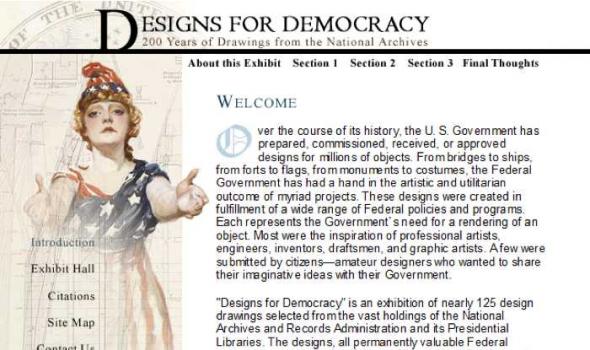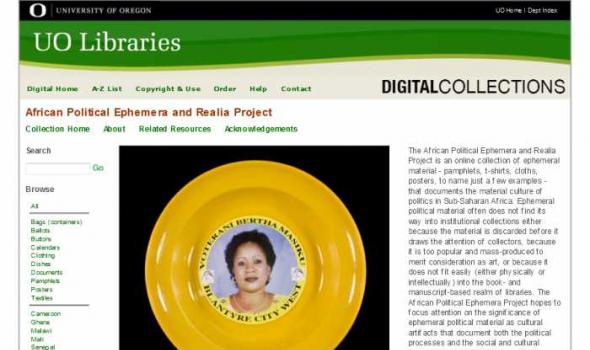Category: Graphic Arts, Image, United States
Results
Donald Angus Collection of Botanical Prints Donald Angus' collection of botanical prints are housed at the Bishop Museum, Foster Gardens, the National Tropical Botanical Garden, and the University of Hawai'i at Manoa Hamilton Library. These exquisite illustrations were published in monographs and journals mainly in the 18th and 19th centuries. They reflect the enthusiasm of scientists, and the popularity of the exotic flora being introduced and cultivated in European botanical gardens. Many prints in the Angus collection are from Monandrian Plants of the Order Scitamineae by William Roscoe (1753-1831). Roscoe, a wealthy banker and amateur botanist, founded the Liverpool Botanic Garden in 1802.
Established in 1916, the Department of Prints and Drawings at The Minneapolis Institute of Arts is responsible for the care, exhibition, and acquisition of works of art on paper. These include woodcuts, engravings, etchings, lithographs, screenprints, drawings, watercolors, pastels, monotypes, multiples, artists' books, and rare books. Ranging from early 14th-century illuminated manuscripts to contemporary works on paper, the Institute's permanent collection of prints and drawings is encyclopedic in scope and comprehensive in graphic media. Featured here is a selection of more than 3800 works from the Museum's permanent collection. Try searching for an artist, title, keyword or country.
The term Modernism commonly applies to those forward-looking architects, designers and artisans who, from the 1880's on, forged a new and diverse vocabulary principally to escape the Historicism, the tyranny of previous historical styles. The foundation of this online project is a group of over 250 objects representing nine Modernist movements.
Our Mission Norman Rockwell Museum is dedicated to education and art appreciation inspired by the legacy of Norman Rockwell. The museum preserves, studies and communicates with a worldwide audience the life, art and spirit of Norman Rockwell in the field of illustration. The museum is a gathering place for reflection, involvement, and discovery through the enjoyment of the artist’s work. Norman Rockwell’s unique contributions to art and society, popular culture and social commentary influence the museum’s programs and interpretations. Nov 7 Wed NRM Twitter Follow @nrockwellmuseum on Twitter Hours November-April: Weekdays 10 a.m. – 4 p.m. – Weekends and holidays: 10 a.m. – 5 p.m.
The collection consists of 105 items (86 lobby cards and 19 printed fliers) promoting sixty-eight films. Cite as: Western Silent Films Lobby Card Collection. Yale Collection of Western Americana, Beinecke Rare Book and Manuscript Library, Yale University Call Number: WA MSS S-2553
Street & Smith Dime Novel Covers Brief History of Street & Smith In 1855, when Francis Scott Street and Francis Shubael Smith bought The New York Weekly Dispatch , Street & Smith embarked on a publishing mission that remained remarkably prolific and profitable for over one hundred years. Street & Smith rapidly became a "fiction factory," producing a wide variety of popular literature, including dime novels, pulp magazines, books in series for juveniles, fashion and homemaking magazines, comics, and adventure stories. The company viewed fiction as a commodity, with Street & Smith editors dictating plots, character types, and other conventions to the firm's stable of writers.
DIGITAL COLLECTIONS About the Collection The Newton Owen Postcard Collection represents nearly a century in the life and travels of an extended Kentucky family. The earliest cards date to the late 19th century, and while the bulk of the collection dates to the period 1900-1940, there are postcards dating to the 1980s as well. It consists of 781 cards, including travel postcards and greeting cards of many different kinds. The Newton Owen Postcard Collection consists of postcards collected by the Bayne, Foell, and Owen families. The Bayne family, consisting of Samuel and Fannie Bayne and their children, Josephine (born 1899), Samuel Junior (born 1901), and Sarah (born 1903).
The National Archives and Records Administration Clifford K. Berryman: Political Cartoonist Extraordinaire In 1886 at the age of 17, Clifford K. Berryman moved from Kentucky to Washington, DC, to work at the U.S. Patent Office, where he used his self-taught talents to draw patent illustrations. He left the Patent Office in 1891 to become a cartoonist’s understudy for the Washington Post. Within five years, Berryman was chief cartoonist, a position he held until 1907 when he became the front-page cartoonist at the Washington Evening Star. Berryman drew political cartoons for the Star until his death in 1949 at the age of 80. Washington political circles embraced Berryman’s cartooning.
Guns, tanks, and bombs were the principal weapons of World War II, but there were other, more subtle forms of warfare as well. Words, posters, and films waged a constant battle for the hearts and minds of the American citizenry just as surely as military weapons engaged the enemy. Persuading the American public became a wartime industry, almost as important as the manufacturing of bullets and planes. The Government launched an aggressive propaganda campaign with clearly articulated goals and strategies to galvanize public support, and it recruited some of the nation's foremost intellectuals, artists, and filmmakers to wage the war on that front.
Federal Designs: Symbolism Symbols are an important part of America`s design heritage. They establish and reinforce the national identity and patriotism. In some cases, American symbols are based on recognized associations. The ideals of Greek democracy, the power of Imperial Rome, or the refinements of European fashion frequently are reflected in Federal designs. At other times and for other purposes, designers created icons using images unique to this new country, to this new form of government, and to America`s aspirations to world power.
During the depths of the Great Depression of the 1930s and into the early years of World War II, the Federal government supported the arts in unprecedented ways. For 11 years, between 1933 and 1943, federal tax dollars employed artists, musicians, actors, writers, photographers, and dancers. Never before or since has our government so extensively sponsored the arts. MORE... This link is not functional because your browser does not support JavaScript or Javascript has been disabled. Please use this link to MORE...
About the Project Named after the pioneering critic of the commercialization of mass media, the late Professor Rose Goldsen of Cornell University, the Archive was founded in 2002 by Timothy Murray to house international art work produced on CD-Rom, DVD-Rom, video, digital interfaces, and the internet. Its collection of supporting materials includes unpublished manuscripts and designs, catalogues, monographs, and resource guides to new media art.
The Johnson Museum has one of the finest collections of art in New York State and is recognized as one of the most important university museums in the country. Spanning the history of art, the Museum's collections are especially strong in Asian art, nineteenth- and twentieth-century American art, and the graphic arts.
About - Oregon Percent for Art Background When an artist applies for a Percent for Art award, the Oregon Arts Commission (OAC) requires that (s)he submit slides, 8 x 10 black and white prints or 35mm negatives of their artwork, along with textual documentation describing the materials used in creating the work. In addition, some artists choose to submit illustrative proposals or project mockups. Many applicants also provide an artist statement as well as an exhibition list or resume. These materials are then reviewed for artist merit and suitability to the facility.
African Political Ephemera and Realia Project Search Browse The African Political Ephemera and Realia Project is an online collection of ephemeral material - pamphlets, t-shirts, cloths, posters, to name just a few examples - that documents the material culture of politics in Sub-Saharan Africa. Ephemeral political material often does not find its way into institutional collections either because the material is discarded before it draws the attention of collectors, because it is too popular and mass-produced to merit consideration as art, or because it does not fit easily (either physically or intellectually) into the book- and manuscript-based realm of libraries.
A project of the Anne S. K. Brown Military Collection Box A Brown University Library Providence, RI 02912 Tel.: (401) 863-2414 ASKB@Brown.edu Developed & hosted by Center for Digital Initiatives Box A Brown University Library Providence, RI 02912 cdi@brown.edu The Collection The Napoleonic satires housed in the Anne S. K. Brown Military collection of the John Hay Library represent several important gifts made to the library in the 20th century. In addition to the Napoleonic satires located in the military collection bequeathed by Ms. Brown, Paul Revere Bullard (Class of 1897) and William H. Hoffman contributed a variety of significant objects with a Napoleonic theme.
Center for Digital Scholarship Box A Brown University Library Providence, RI 02912 cds_info@brown.edu About This Collection Researchers may note some overlap between Lincoln Graphics and Lincoln Broadsides. Indeed, the line between a broadside and a graphic representation can be hard to define. In general, however, graphics will contain more image than text, while for broadsides that relationship is reversed. Brown’s Lincoln Graphics collection is immense, and researchers are cautioned that this digital collection presents only a portion of it. We hope to digitize more of the collection in due course, but this will take time.
About the Collection The UWM Book Arts Collection contains scanned images of selected artists’ books from the UWM Special Collections-Book Arts Collection. The goal of the UWM Special Collections-Book Arts Collection has been to document and demonstrate the use of the book form as an art medium. The collection’s main focus is on examples of artists' books from the late nineteenth century to the present. Largely represented are examples of American book arts, especially those of the Upper Midwest.
Bliffert Collection The Thomas and Jean Ross Bliffert Postcard Collection consists of about 12,000 postcards on a broad range of local, regional, national and international subjects. Thomas and Jean Ross Bliffert, who have been actively collecting postcards since 1945, donated the collection to the UW-Milwaukee Libraries beginning in September 1998. Although the collection is still being processed, it may be accessed upon request in Special Collections at the UWM Libraries.
America's First Illustrator: Alexander Anderson Sixteen scrapbooks, containing close to 10,000 wood-engravings by 19th-century master illustrator Alexander Anderson. Collection History Sixteen scrapbooks, containing close to 10,000 wood-engravings by 19th-century master illustrator Alexander Anderson. Background Alexander Anderson (1775-1870) is considered one of America’s earliest and finest wood-engravers. During a career spanning seventy years, he produced a large number of illustrations for books, periodicals, newspapers, and other commercial ephemera, after both his own designs and those of other artists. Related Resources Books illustrated by Anderson are available in large libraries with strong 19th-century holdings, including NYPL.
Historical Collections Exhibit As new consumer markets developed following the Civil War, the advertising trade card met the need for an effective national advertising medium and heralded the arrival of an extraordinary variety of manufactured goods newly available to the American public. An exhibition organized by the Historical Collections Department of Baker Library. Search Catalog records for 1,000 of Baker Library's advertising trade cards, with accompanying digital images, are now available through the Visual Information Access (VIA) system, an online catalog of visual resources at Harvard. Baker Library holds more than 8,000 trade cards representing the full range of products and businesses advertised through this medium from the 1870s through the 1890s.









































